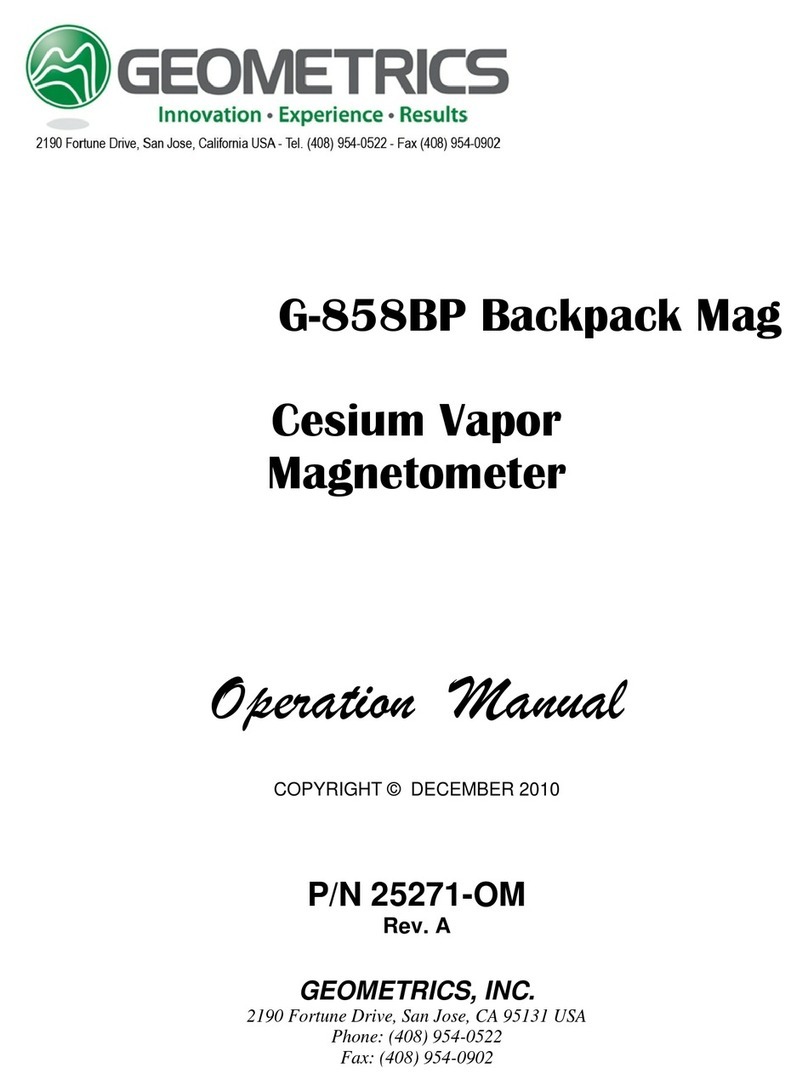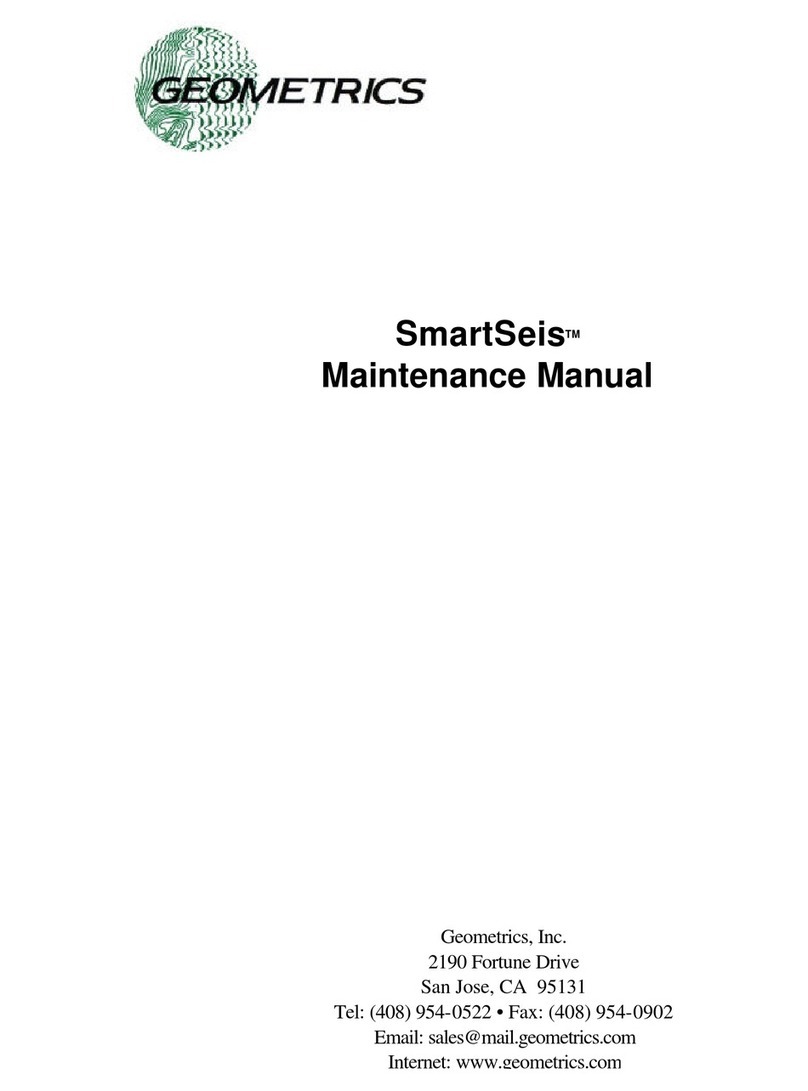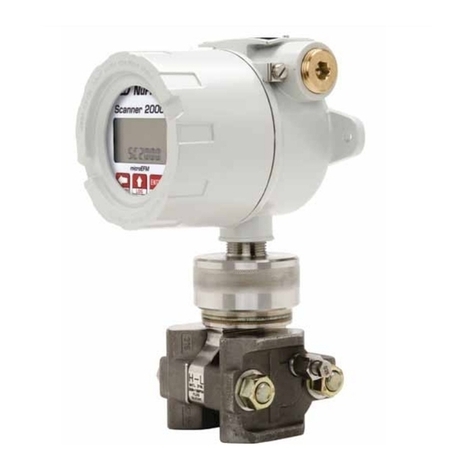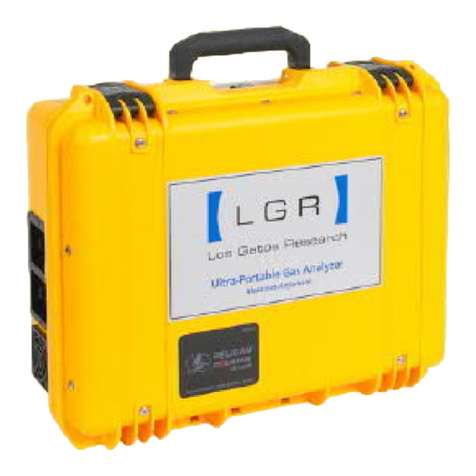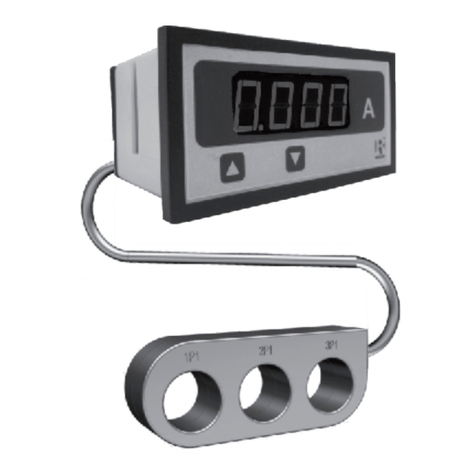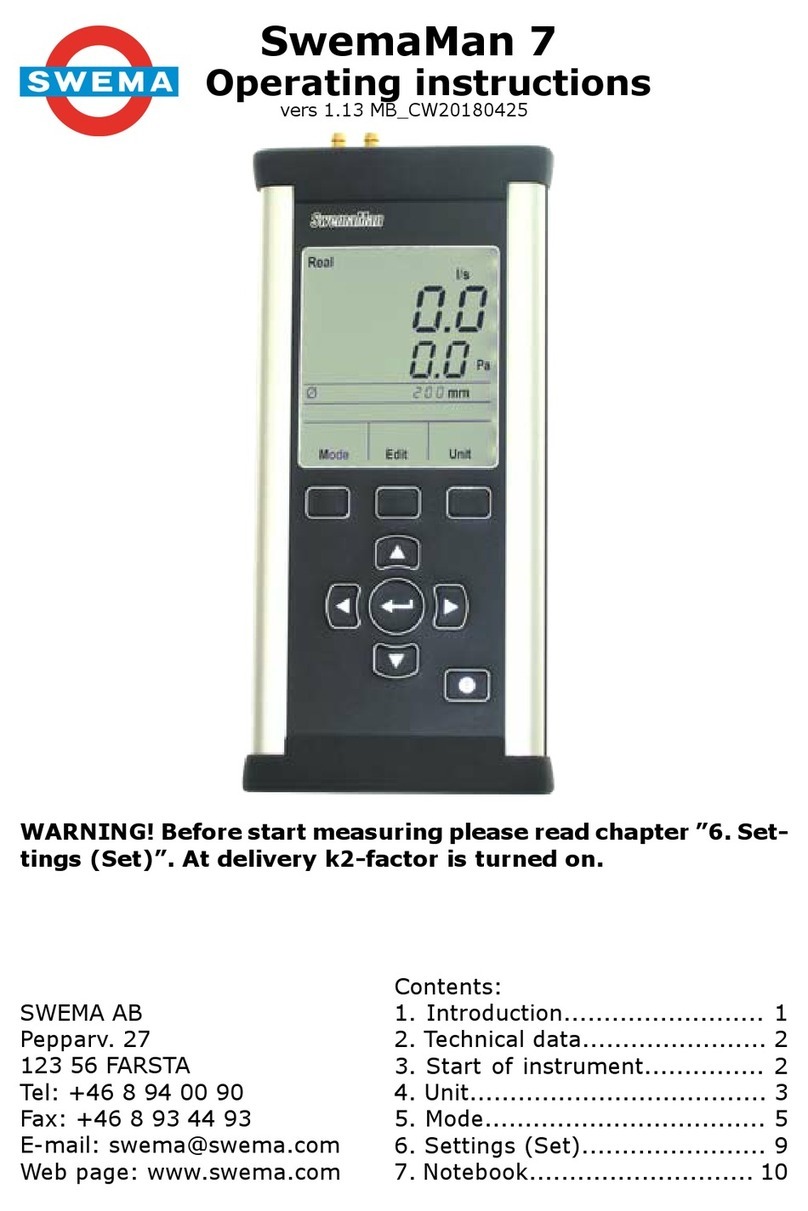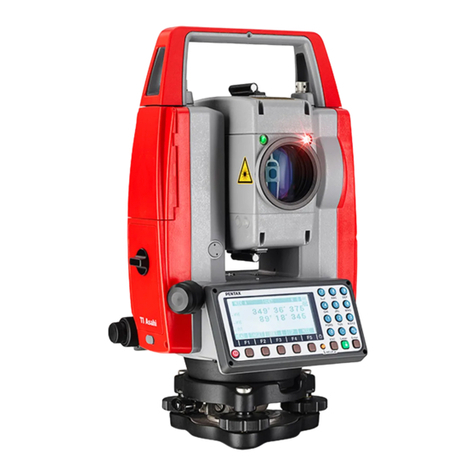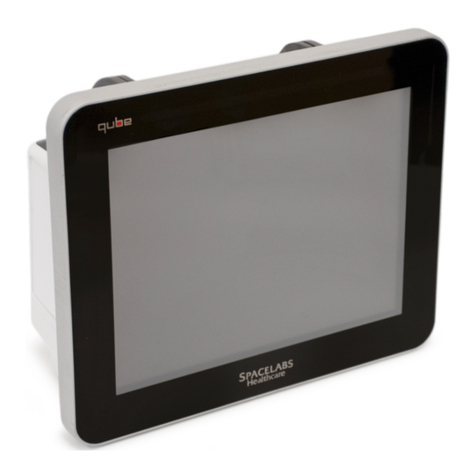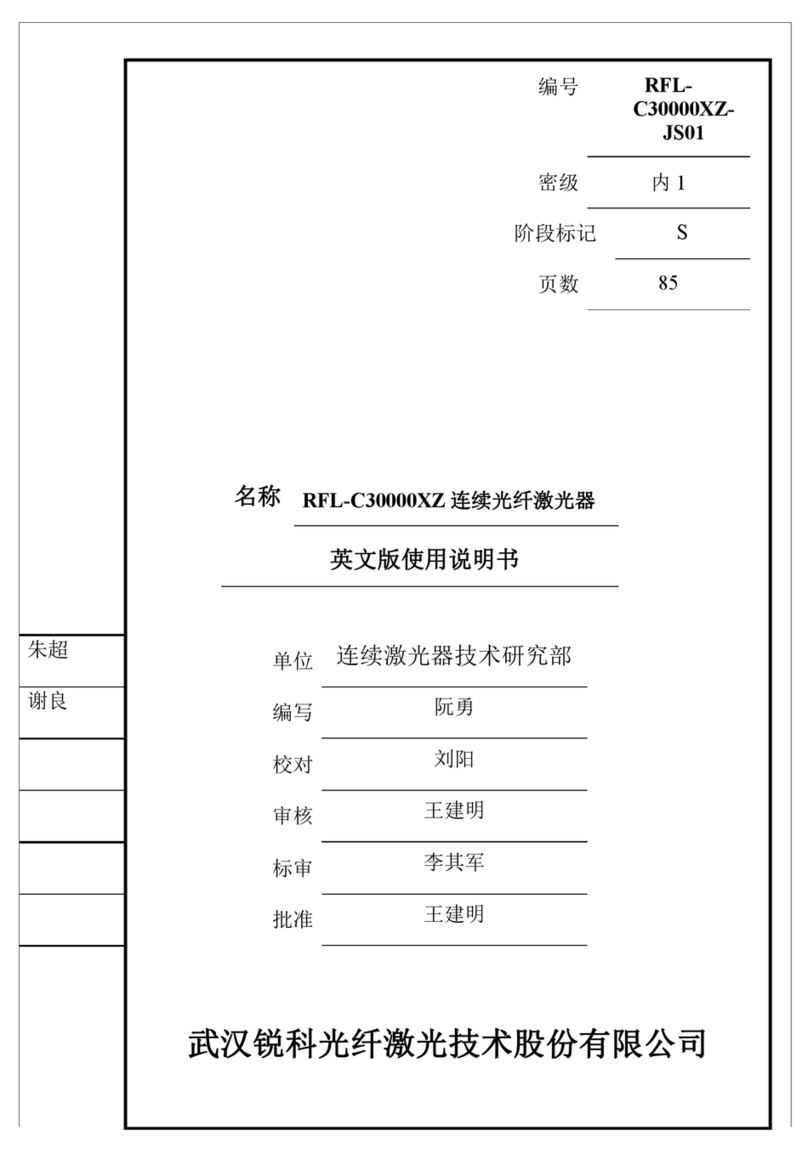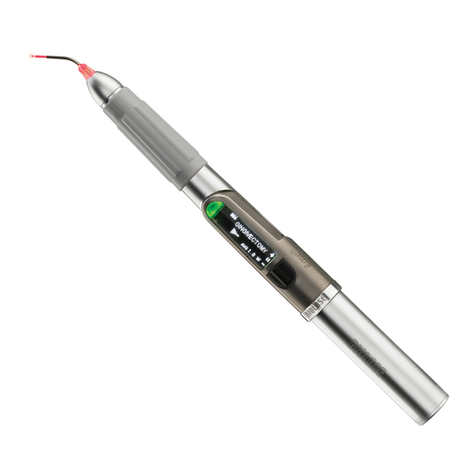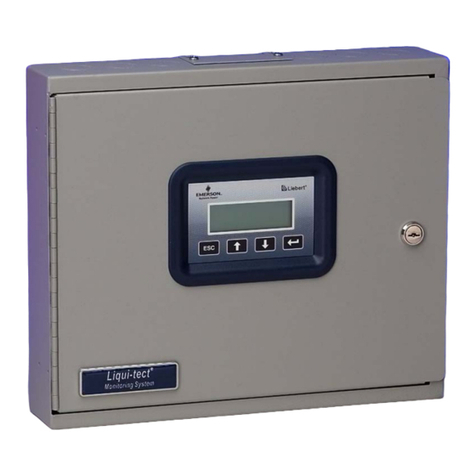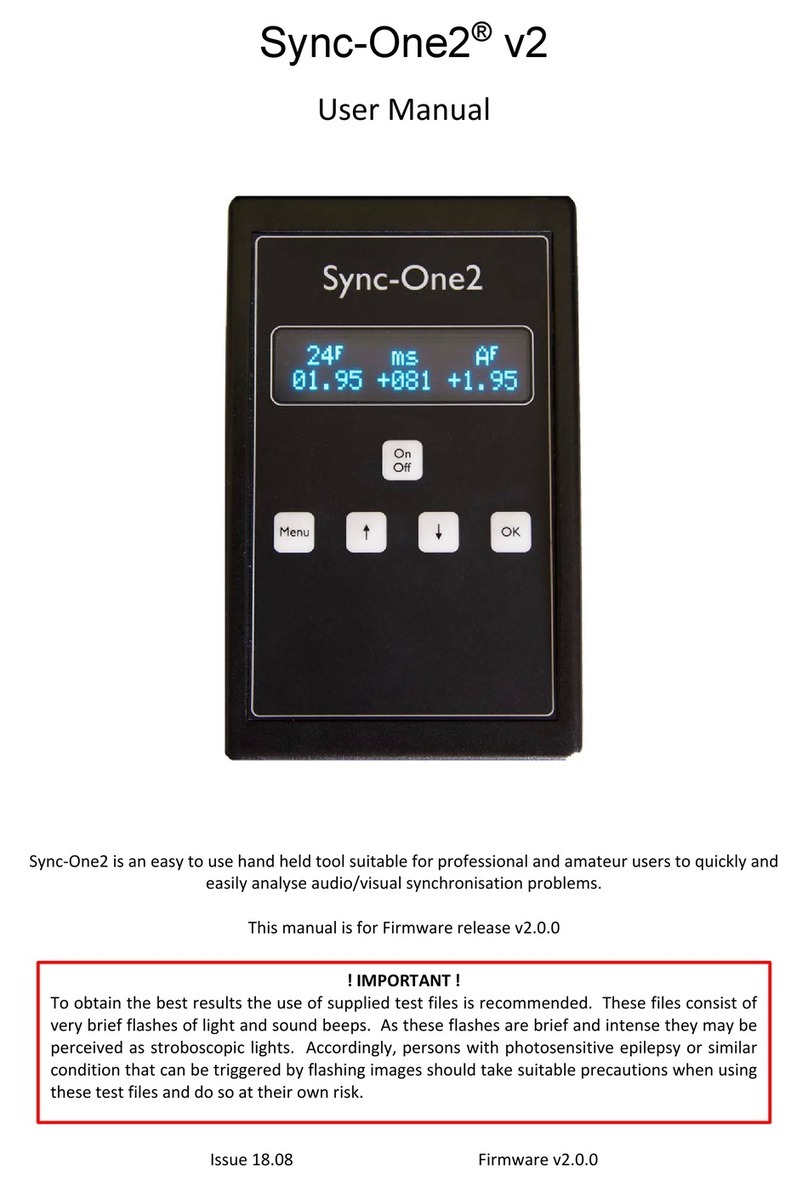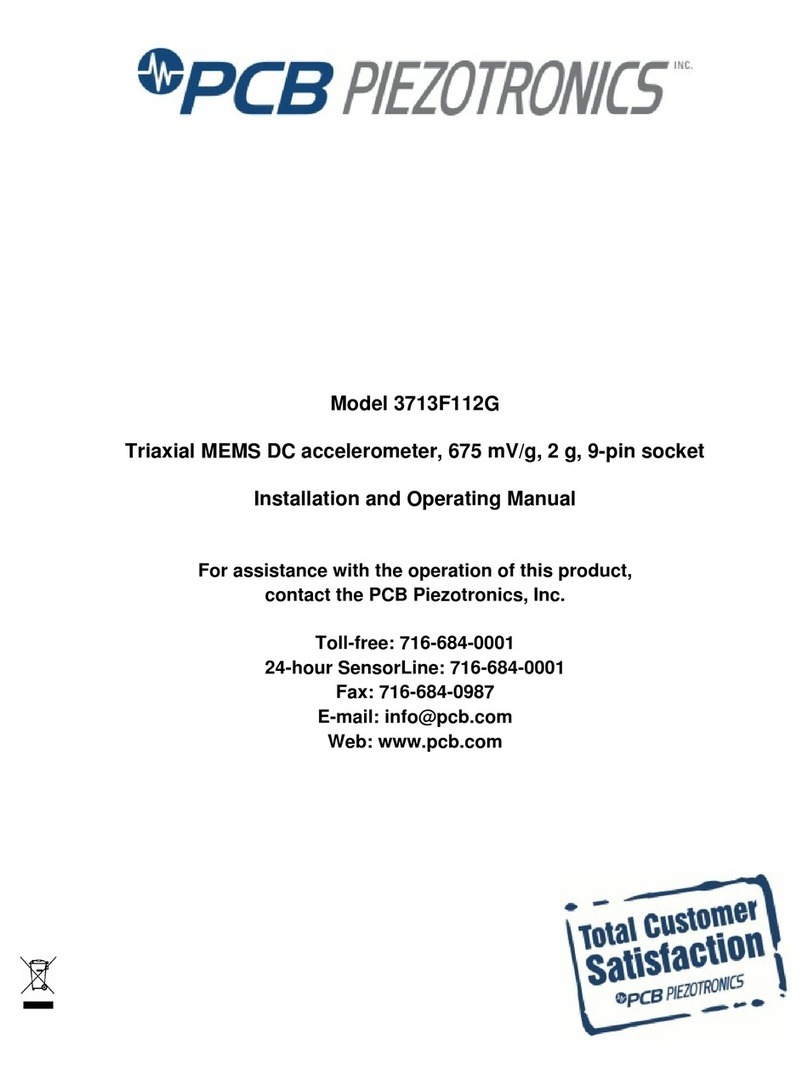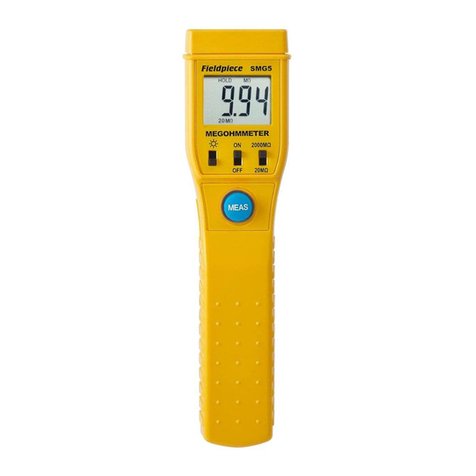Geometrics Memory-Mag G-857 User manual

Geometrics, Inc. G-857 Operation Manual
i
G-857 Memory-Mag
Proton Precession
Magnetometer
P/N 18103-02 Rev. C
Operation Manual
GEOMETRICS, INC.
2190 Fortune Drive, San Jose, CA 95131
Phone: (408) 954-0522
Fax: (408) 954-0902
Web: www.geometrics.com
COPYRIGHT © 2015

Geometrics, Inc. G-857 Operation Manual
ii

Geometrics, Inc. G-857 Operation Manual
i
Table of Contents
INTRODUCTION............................................................................................................. 1
WHAT IS A TOTAL FIELD MAGNETOMETER? ..................................................................... 1
MAGNETOMETER APPLICATIONS...................................................................................... 1
TERMS USED IN THIS MANUAL.......................................................................................... 2
THE G-857....................................................................................................................... 2
MAGNETOMETER SET-UP.......................................................................................... 5
SENSOR FLUIDS................................................................................................................ 5
STANDARD SYSTEM ASSEMBLY....................................................................................... 6
GRADIOMETER ASSEMBLY............................................................................................. 11
BASE-STATION ASSEMBLY............................................................................................. 15
GPS ASSEMBLY AND SETUP .......................................................................................... 16
SENSOR ORIENTATION.................................................................................................... 17
CONSOLE SET-UP........................................................................................................ 19
CONSOLE CONTROLS AND DISPLAY............................................................................... 19
SYSTEM CHECKOUT........................................................................................................ 20
OPERATING PROCEDURES............................................................................................... 21
1 - Clearing a Key sequence..................................................................................... 21
2 - Setting the internal clock..................................................................................... 21
3 - Setting the Year.................................................................................................... 22
4 - Setting the Line Number Marker......................................................................... 22
5 - Setting GPS Recording Mode.............................................................................. 22
6 - Manual Tuning of the Magnetometer.................................................................. 23
7 - Automatic tuning.................................................................................................. 25
8 - Acquiring and storing a magnetic field reading.................................................. 26
9 - Recalling measurements from memory................................................................ 27
10 - Erasing magnetometer readings........................................................................ 28
11 - Automatic reading set-up................................................................................... 30
12 - Retrieving magnetic field readings.................................................................... 31
13 - Clock set from GPS Time................................................................................... 32
FIELD OPERATION..................................................................................................... 33
SENSOR POSITION AND MEASUREMENT REPEATABILITY................................................. 33
MAGNETIC ENVIRONMENT ............................................................................................. 34
MAGNETIC SURVEYING.................................................................................................. 34
GPS Error Messages................................................................................................. 34
Standard operation ................................................................................................... 35
Gradiometer operation ............................................................................................. 37
Base station operation .............................................................................................. 38
DATA RETRIEVAL ...................................................................................................... 39
COMPUTER CONNECTION AND DOWNLOAD .................................................................... 39
G-857 format download............................................................................................ 39

Geometrics, Inc. G-857 Operation Manual
ii
Legacy format download........................................................................................... 45
MANUAL TRANSCRIPTION.............................................................................................. 46
AUTOMATIC TRANSCRIPTION IN REAL TIME.................................................................. 47
MAINTENANCE............................................................................................................ 49
INSTRUMENT STORAGE .................................................................................................. 49
VOLTAGE INDICATOR..................................................................................................... 49
BATTERIES..................................................................................................................... 49
GEL-CELL BATTERIES..................................................................................................... 50
LITHIUM BATTERY ......................................................................................................... 50
APPENDIX...................................................................................................................... 53
MAGNETIC FIELD INCLINATION (DEGREES) .................................................................... 53
MAGNETIC FIELD INTENSITY VARIATION (NT) ............................................................... 53
TROUBLESHOOTING ....................................................................................................... 54
RS-232 INTERFACE ........................................................................................................ 56
FRONT PANEL CONNECTOR PIN ASSIGNMENT ................................................................. 57
LEGACY MODE ON OUTPUT FORMAT............................................................................ 58
LEGACY MODE OFF OUTPUT FORMAT........................................................................... 59
AUTO CYCLE OUTPUT FORMAT ..................................................................................... 61
EXTERNAL POWER......................................................................................................... 61
EXTERNAL MAGNETOMETER CONTROL .......................................................................... 62
INTERNAL PROGRAMMING SWITCHES............................................................................. 63
Polarize and count time –Switches 1 through 4....................................................... 64
INTERNAL RESET SWITCH .............................................................................................. 67
SPECIFICATIONS............................................................................................................. 68
WARRANTY AND SERVICE.............................................................................................. 69
FIRMWARE REVISIONS.................................................................................................... 71
Table of Figures
Figure 1. G-857 proton-precession magnetometer. ........................................................... 6
Figure 2. Sensor staff sections. .......................................................................................... 7
Figure 3. Sensor preparation.............................................................................................. 8
Figure 4. Staff / sensor assembly....................................................................................... 8
Figure 5. Console battery compartment............................................................................. 9
Figure 6. G-857 Shoulder harness. .................................................................................. 10
Figure 7. Assembled magnetometer ................................................................................ 10
Figure 8. Location of 'Read' key on magnetometer console............................................ 11
Figure 9. Gradiometer components.................................................................................. 12
Figure 10. Removing standard sensor cable from top sensor.......................................... 12
Figure 11. Top sensor with gradiometer cable attached .................................................. 13
Figure 12. Bottom sensor with gradiometer cable attached............................................. 13
Figure 13. Connection of threaded staff adaptors............................................................ 13
Figure 14. Completed gradiometer staff.......................................................................... 14

Geometrics, Inc. G-857 Operation Manual
iii
Figure 15. Attach the gradiometer switch box................................................................. 14
Figure 16. Base-station setup up using tripod kit and G-857 staff section...................... 15
Figure 17. Garmin Oregon GPS Option ........................................................................... 16
Figure 18. Alternate orientations for G-857 sensor mount.............................................. 18
Figure 19. Magnetic Inclination of the Earth’s field........................................................ 18
Figure 20. G-857 console display and keypad................................................................. 19
Figure 21. Magnetic Field Intensity Variation, (nT)........................................................ 24
Figure 22. Typical survey layout...................................................................................... 37
Figure 23. Location of console’s internal programming switch...................................... 63
Figure 24. Internal reset switch........................................................................................ 67
List of Tables
Table 1. An example of the console memory stack......................................................... 27
Table 2 GPS Error Messages.......................................................................................... 35
Table 3. RS-232 cable connector pin assignment............................................................ 56
Table 4. Summary of programmable switch settings....................................................... 64

Geometrics, Inc. G-857 Operation Manual
iv

Geometrics, Inc. G-857 Operation Manual
1
Introduction
This manual provides operating instructions for Geometrics G-857 portable proton-
precession magnetometer. It includes step-by-step instructions on magnetometer set-up,
survey usage, measurement data retrieval, and maintenance.
What is a total field magnetometer?
A total field magnetometer is an instrument that measures the scalar intensity of the local
magnetic field. The G-857 relies upon the proton-precession measurement technique.
This technique makes use of an induction coil to create a strong magnetic field around a
hydrogen-rich fluid such as Kerosene. This causes the hydrogen protons to align or
polarize their spin axis with the newly applied magnetic field. When the current
producing the polarizing field is interrupted, the protons begin to align themselves with
the Earth's magnetic field; but in doing so will momentarily precess about the Earth’s
field at a specific frequency that is proportional to the ambient magnetic field intensity.
This precession generates a small magnetic field that induces an alternating voltage in the
induction coil that was previously used to generate the polarization field. The
relationship between the precession frequency of the induced voltage and the strength of
Earth's magnetic field is called the proton gyromagnetic ratio and is equal to 0.042576
Hertz per nanoTesla (Hz/nT).
Magnetometer applications
Most rocks contain some magnetite, hematite or other magnetic material and will produce
disturbances in the local magnetic field. Because of this, most soils and many man-made
objects that contain iron or nickel have magnetic properties detectable by a sensitive
magnetometer because they create local or regional anomalies in the Earth’s main field.
Anomalies are revealed by systematic measurement of the variation in magnetic field
strength with position.
Interpretation of magnetometer readings allows the surveyor to make inferences about
what exists beneath the Earth’s surface. Based on experience with the survey area, the
surveyor might interpret the measurements to indicate to location of a pipeline, fired
pottery or bricks, a piece of ordnance, a particular mineral or geologic structure. The
interpretation of magnetic survey results is sometimes a difficult task, made even more
complex by constant changes in the Earth's overall magnetic field, the size and distance
of objects from the magnetometer, the amount of magnetic material the object contains,
as well as the magnetic susceptibility of the object and the host material. On the other
hand, in many applications, simple interpretations of anomalous magnetic fields will lead
to a straightforward understanding of the source of the anomaly.
The proton precession magnetometer is one of the principal instruments for magnetic
surveys because it combines high accuracy and ease of use. The Applications Manual for
Portable Magnetometers, supplied with this instrument and available for download from

Geometrics, Inc. G-857 Operation Manual
2
our website, includes general information on the use of magnetometers. It should be
studied as a companion to this manual which deals specifically with the G-857 Memory
Mag™.
Terms used in this manual
The magnetic field intensity at the surface of the Earth has an average value of about
50,000 nano-Tesla (nT). Historically, one nT is sometimes referred to as a gamma or “”.
Throughout this manual we will always express field intensity in nT.
The terms “sampling”, “cycling”, and “reading” all refer to the magnetometer’s
measurement of the field intensity. Note that these terms do not necessarily refer to both
measurement and internal storage of the measurement value.
The G-857
Depending on its particular configuration, the G-857 can be a portable, man-carried
magnetometer, a gradiometer measuring the field with two sensors, or a "base station"
magnetometer. The G-857 can record optional Garmin GPS in all configurations. As a
hand-carried instrument, it features simple, push button operation and a built-in digital
memory that stores 65,000 single sensor measurements or 32,500 gradiometer readings.
This relieves the user of the need to physically write down the data in the field, eliminates
transcription errors and most importantly, allows the use of computers to automatically
record and process the data from the magnetic survey. Software Programs are available
from Geometrics to help the user process and interpret survey data. These programs
include MagMap2000 and MagPick and are available for download from our website:
www.geometrics.com.
The G-857 can also record data automatically at regular intervals, so it can be left
unattended to monitor diurnal changes in the earth's magnetic field. These readings (up to
65,000) are collected at a base station and used to correct simultaneous field
measurements for high accuracy surveys. Measurement data from the G-857 may also be
fed directly into an external computer. The time-of-day generated by the magnetometer’s
internal clock is recorded with each reading taken in either mode.
All operations are controlled from keys imbedded in a weatherproof membrane that
comprises the magnetometer console’s front panel. The key sequences for the various
magnetometer operations have been carefully designed to provide simple yet flexible
operation.
A single connector is used for the sensor signal input and data output. The output format
is in the universal RS-232 protocol that is accepted by most modern computers. Interface
software for downloading, profiling and gridding/contouring of data is provided by
Geometrics MagMap2000 software. A serial to USB converter is supplied for use with
computers that are not equipped with a serial port.

Geometrics, Inc. G-857 Operation Manual
3
Physically, the G-857 is compact and lightweight. It is weatherproof and operates over a
wide temperature range. It is powered either by an internal rechargeable lead acid gel
cell battery or an external 12 Volt battery.
Unlike other proton-precession magnetometers, the G-857 has an internal programming
switch which allows modification of the magnetometer’s cycle times to ensure that it will
work properly anywhere in the world.
Above all, the G-857 is a high-precision magnetometer, the result of many years of
experience in the manufacture of similar instruments. The operation of the instrument is
controlled by a microprocessor and the control program may be changed at any time for
product improvement or other considerations. In that event, you may find variations
between this manual and the operation of your actual instrument. Such variations will
have no adverse effect and should be recognizable as you familiarize yourself with
operation.

Geometrics, Inc. G-857 Operation Manual
4

Geometrics, Inc. G-857 Operation Manual
5
Magnetometer Set-up
The standard G-857 system is used as a mobile instrument for measurement of the
magnetic field intensity sequentially at discrete locations. With the appropriate
accessories the standard system can be configured for measurement of the differential
magnetic field (gradient) over the survey area or the magnetometer can be set up to
record the temporal changes in the magnetic field intensity at a fixed point to acquire
base station measurements.
Sensor fluids
The sensor contains coils of insulated wire and for optimum operation these coils must be
submerged in a hydrogen-rich fluid. The following section provides information about
this fluid and the correct procedure for filling the sensor with fluid.
It is important that you DO NOT operate the sensor for an extended period without
fluid as this can damage the sensor. The sensor should be filled so that the fluid level is
about 1 cm below the fill port. There is a fill port tube inside the sensor that provides for
an air gap when the sensor is filled. Correct fluid level can be checked approximately by
shaking the sensor and judging the fluid level by the degree of sloshing. A more accurate
level check requires removal of the sensor’s fill plug and visual inspection of the
contents. If the sensor is empty or needs filling proceed as follows:
A. Place the sensor on a flat, level surface.
B. Remove the blue cap plug on the sensor. Observe that the fill-port is a threaded
tube extending into the sensor vessel. This design provides a 1 cm air gap that
allows for thermal expansion of the sensor fluid.
C. Fill with acceptable sensor fluid to within 1 cm from the top. Acceptable fluids
for proton-precession magnetometers include:
Shell SOL-71 (Shell Oil Co. product).
Charcoal Lighter Fluid (Kingsford, Wizard, etc.)
n-Decane (chemical supply houses, oil refineries)
ISOPAR-1 (Exxon Oil Co. product)
Odorless Mineral Spirits (also known as Naptha)
Kerosene
D. Pour only clear fluid into the sensor. If fluid is dirty use a paper coffee filter or
fine screen to eliminate particles.
E. Slowly pour fluid into sensor until it is full. The sensor is full when the fluid just reaches
the bottom of the fill-port as described above.
F. Place Teflontape around the fill plug; then screw it into the fill-port and tighten. Note:
the fill plug and fill-port have tapered threads designed to form a tight seal. Tighten the
plug just enough to prevent leakage - over tightening may crack or damage the sensor
housing.
G. Sensor is now ready for use.

Geometrics, Inc. G-857 Operation Manual
6
The different sensor fluids listed above will provide slightly different signal amplitudes
but their use will ensure that the magnetometer measures the magnetic field strength
correctly and that the sensor will not be damaged interacting with the fluid. Geometrics
does not recommend the use of gasoline (petrol) as a sensor fluid. Experience has shown
that local formulation of gasoline may include additives that can damage the sensor. Do
not put any solvent containing acetone or toluene into the sensor: these will dissolve the
sensor body.
Standard System Assembly
As shown in Figure 1 the standard G-857 comes packed in a durable plastic carrying
case, with compartments for its accessories. It contains:
G-857 console (P/N 16601-34)
Sensor (P/N 16076-01)
Sensor signal cable (P/N 16134-01)
Aluminum staff (four (4) mating sections) (P/N 16005-03)
Console chest harness (P/N 25332-01)
Two (2) rechargeable lead acid battery packs and charger (P/N 16697-02, P/N
16699-04)
G-857 Operator's Manual (on CD) (P/N 18103-02)
Application Manual for Portable Magnetometers (on CD)
MagMap2000 Software and Manual (on CD)
RS232 Data Output Cable (P/N 16492-01)
USB/RS232 Serial Convertor (P/N 20-000-071)
If the magnetometer is new it was shipped without sensor fluid. Before the
magnetometer will operate correctly the sensor must be filled with the appropriate
fluid. See the preceding section for a list of appropriate sensor fluids.
Figure 1. G-857 proton-precession magnetometer.

Geometrics, Inc. G-857 Operation Manual
7
Assembly of the magnetometer is quite simple. Proceed as follows referring to Figure 2
through Figure 8.
1) Assemble the staff by inserting the black bolt on each section into the slot of the
next section, and tightening them until they are locked. As shown in Figure 2a,
there are four staff sections. The section with the rubber tip is the bottom section
and the section with the treaded end is the top section. Figure 2b shows the bolt-
lock end of the staff section. This end is inserted into the open slit on the end of
the matching section.
a b
Figure 2. Sensor staff sections.
2) Verify that the sensor contains fluid. You may shake the sensor to determine if
contains fluid. A sloshing sound indicates proper filling. Some air space above
the fluid is needed for thermal expansion - see instructions on sensor fluids in this
section for details. Figure 3a shows the location of the sensor fluid fill port and
the mounting points of the sensor cable. Any tools used for adding fluid,
tightening fasteners or the port plug should either be non-magnetic or have a
clean, rust free hard-chromed finish.

Geometrics, Inc. G-857 Operation Manual
8
Fill port
Electrical
connection
Strain
relief
a
Use pliers or
nut driver to
tighten
fasteners
b
Figure 3. Sensor preparation.
Note: Geometrics recommends using non-magnetic tools for this task and it is
important to use the original brass nuts and washers supplied with the instrument as
substitutes could be contaminated with ferrous material.
3) Mount the sensor on the threaded staff section. As shown in Figure 4a and b,
there are two ways the sensor can be mounted, either vertically, on its end or
horizontally on its side. For now, mount it vertically as shown in Figure 4a.
a b
Figure 4. Staff / sensor assembly

Geometrics, Inc. G-857 Operation Manual
9
4) Remove the console cover by flipping the plastic tabs on its sides outward and
sliding the cover completely off as shown in Figure 5a and b. Connect the
internal rechargeable gel-cell battery. Gel-cell batteries are held in place with a
cover secured by a knob as shown in Figure 5c. Close and latch the battery cover
after inserting and connecting a freshly recharged battery. Then reinstall the
cover before proceeding.
a b
c
Figure 5. Console battery compartment
5) The magnetometer is shipped with the signal cable attached to the sensor. If this
cable is not connected to the sensor connect it as shown in Figure 3b. The sensor
cable terminals are secured to the studs with brass washers and brass nuts. Do not
substitute other hardware for these parts unless they’re completely non-ferrous.
Tighten the terminal nuts finger-tight and then tighten an additional 1/4 turn
(between 18 in-lb. and 24 in-lb.). Connect the signal cable to the magnetometer.
6) Put the console harness on as shown in Figure 6a. Hold the console to your chest
and clip the shoulder strap to the D-ring on the console holster as shown in Figure
6b. Do the same with the waist strap and then repeat this procedure on the other
side of the holster. Adjust the harness so that the console is centered on your
torso as shown in Figure 6c.

Geometrics, Inc. G-857 Operation Manual
10
a b c
Figure 6. G-857 Shoulder harness.
7) Raise the sensor staff assembly to a vertical position and hold it steady for 3-4
seconds before taking a reading. Figure 7a shows the completed assembly ready
for measurement. Figure 7b shows an alternate method for carrying the staff with
the sensor with its central axis vertical. This method uses the saddle mount as the
attachment point for the staff and will require a non-magnetic counter weight
(available from the factory).
a b
Figure 7. Assembled magnetometer
8) Verify that the console is powered and properly connected to the sensor by
momentarily depressing the READ key. The position of this key is shown in
Figure 8. The displays will light, turn off, then light again for 5 seconds. If the
displays did not light, check battery power or the Troubleshooting Appendix in
this manual.

Geometrics, Inc. G-857 Operation Manual
11
Figure 8. Location of 'Read' key on magnetometer console
Gradiometer Assembly
G-857 gradiometer operation requires an optional set of accessories. These items are
shown in Figure 9 and include:
Gradiometer Box (P/N 16654-01)
Gradiometer sensor (P/N 16076-02)
Lower staff adapter (P/N 16530-02)
Upper staff adapter (P/N 16531-02)
Two Gradiometer sensor cables (P/N 16653-01M)

Geometrics, Inc. G-857 Operation Manual
12
Gradiometer, Central Sensor Adapter, Locking (P/N 16529-05)
Velcro attachment pack (P/N 32-504-006)
Figure 9. Gradiometer components
Proceed with gradiometer assembly as follows:
1) Start by removing the standard (single sensor) cable from the top sensor. This
will require removal of the sensor clamp and brass stud nuts as shown in
Figure 10a and 10b.
a b
Figure 10. Removing standard sensor cable from top sensor
Note: Geometrics recommends using non-magnetic tools for this task and it is
important to use the original brass nuts and washers supplied with the instrument as
substitutes could be contaminated with ferrous material.
2) Attach one of the thinner gradiometer sensor cables to the top sensor as shown
in Figure 11 using the stud nuts washers and clamp that secured the standard
cable.

Geometrics, Inc. G-857 Operation Manual
13
Figure 11. Top sensor with gradiometer cable attached
3) As shown in Figure 12, attach the other gradiometer sensor cable to the
bottom sensor in the same manner used on the top sensor.
Figure 12. Bottom sensor with gradiometer cable attached
4) Next, connect the threaded staff adaptor parts to the top of one staff section
and the bottom of another staff section as shown in Figure 13a. The bottom
sensor is configured with opposing mounting points and the adaptors should
be screwed into one set of these mounting points as shown in Figure 13b.
a b
Figure 13. Connection of threaded staff adaptors
5) The separation between gradiometer sensors is determined by the lengths and
number of the staff sections linking the sensors. The minimum separation will
always include one of the threaded adaptors and the top (threaded) staff

Geometrics, Inc. G-857 Operation Manual
14
section as shown in Figure 14. Typical sensor separation will be two staff
sections (4ft.). Note that Figure 14 shows only one staff section separating the
sensors. Normally, two staff sections will support the bottom sensor so that
the top sensor is at 8 ft. and the lower sensor at 4 ft. With any gradiometer
configuration it is best to hold the staff at arm’s length when measuring the
gradient. This will prevent the lower sensor from coming too close to the
console and better isolate it from the magnetic effects of the system circuitry
and batteries.
Figure 14. Completed gradiometer staff
6) The sensor cables may now be connected to the Remote Start Switch box, and
the Remote Start Switch box may be connected to the G-857 front panel
connector. As shown in Figure 15, attach the Velcro strip to the top of the G-
857 black front panel bezel. Mount the Remote Start Switch box to this
mating Velcro strip.
a
b
Figure 15. Attach the gradiometer switch box
Other manuals for Memory-Mag G-857
1
Table of contents
Other Geometrics Measuring Instrument manuals
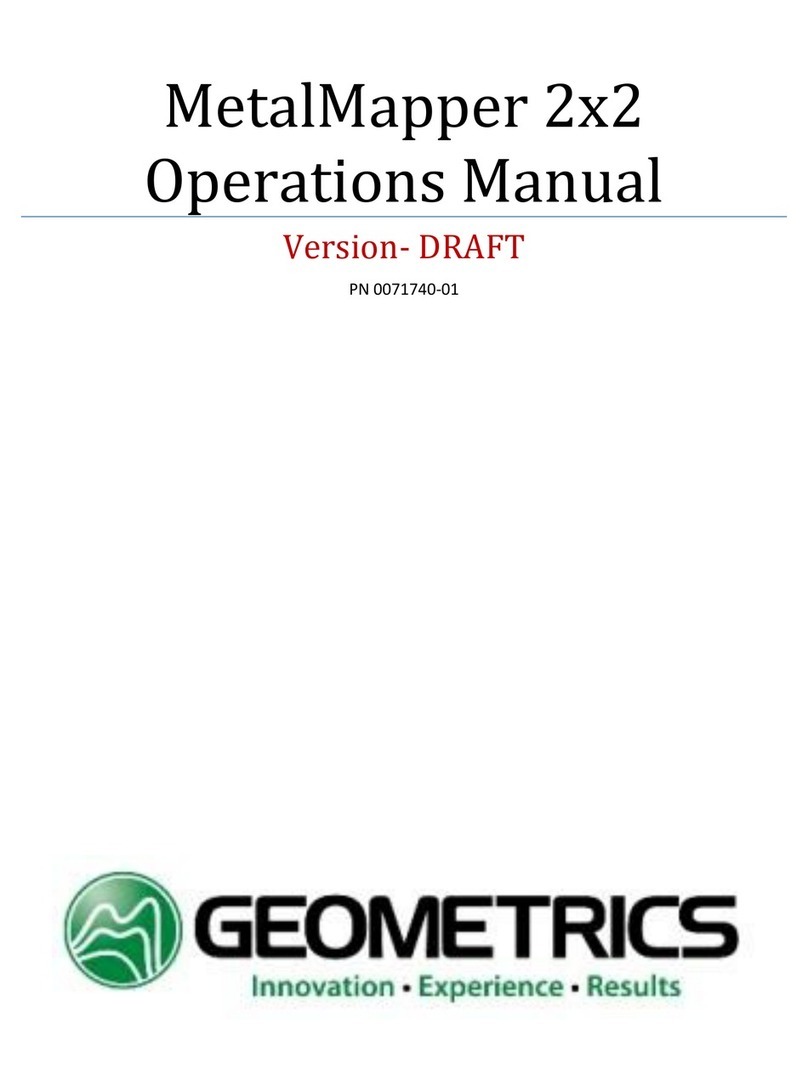
Geometrics
Geometrics MetalMapper 2x2 User manual
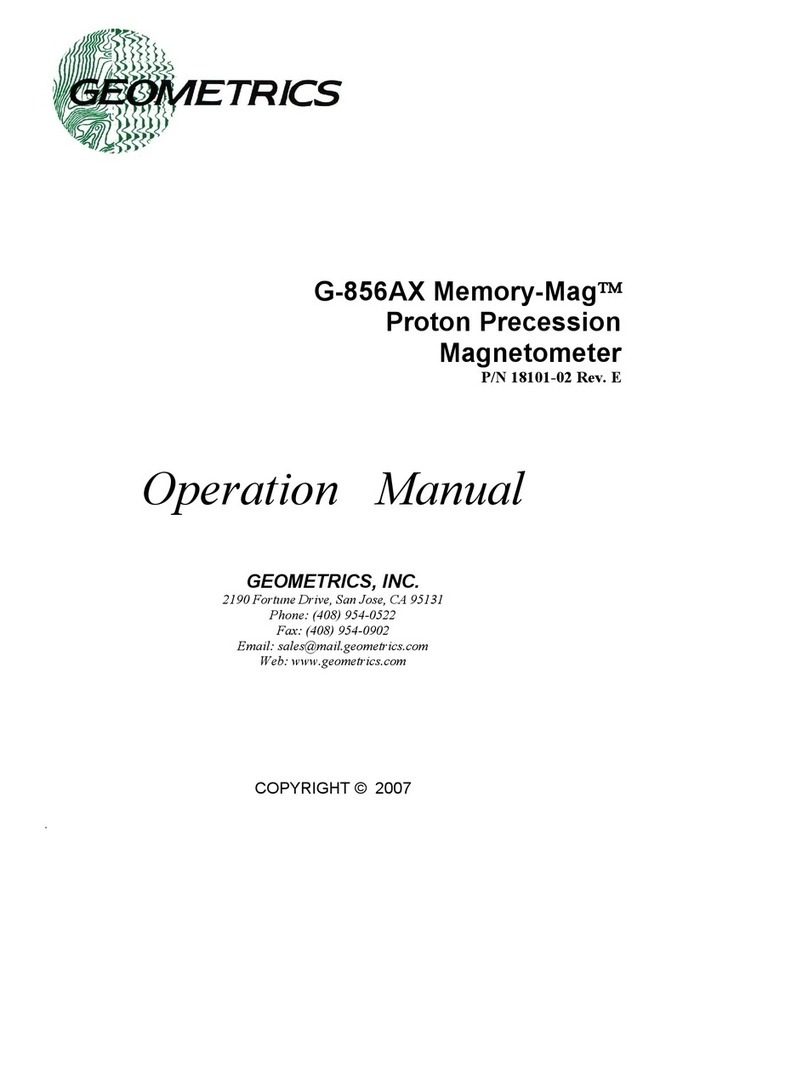
Geometrics
Geometrics Memory-Mag G-856AX User manual
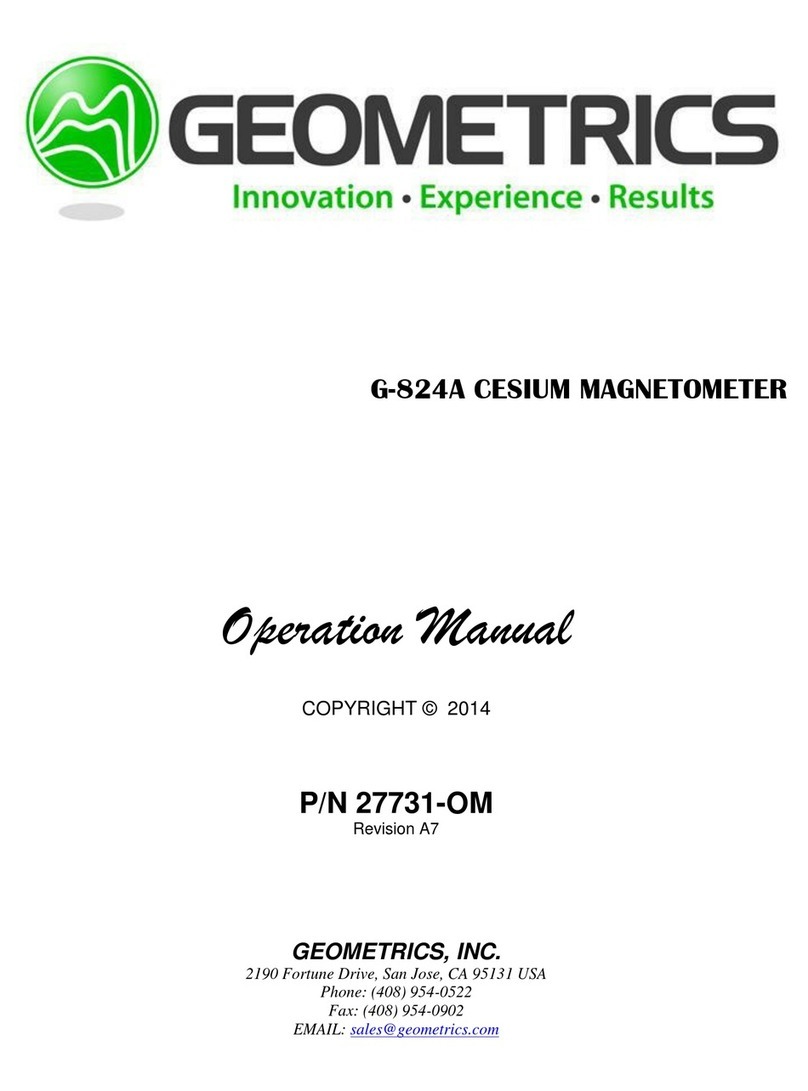
Geometrics
Geometrics G-824A User manual

Geometrics
Geometrics Memory-Mag G-857 User manual

Geometrics
Geometrics MagEx User manual
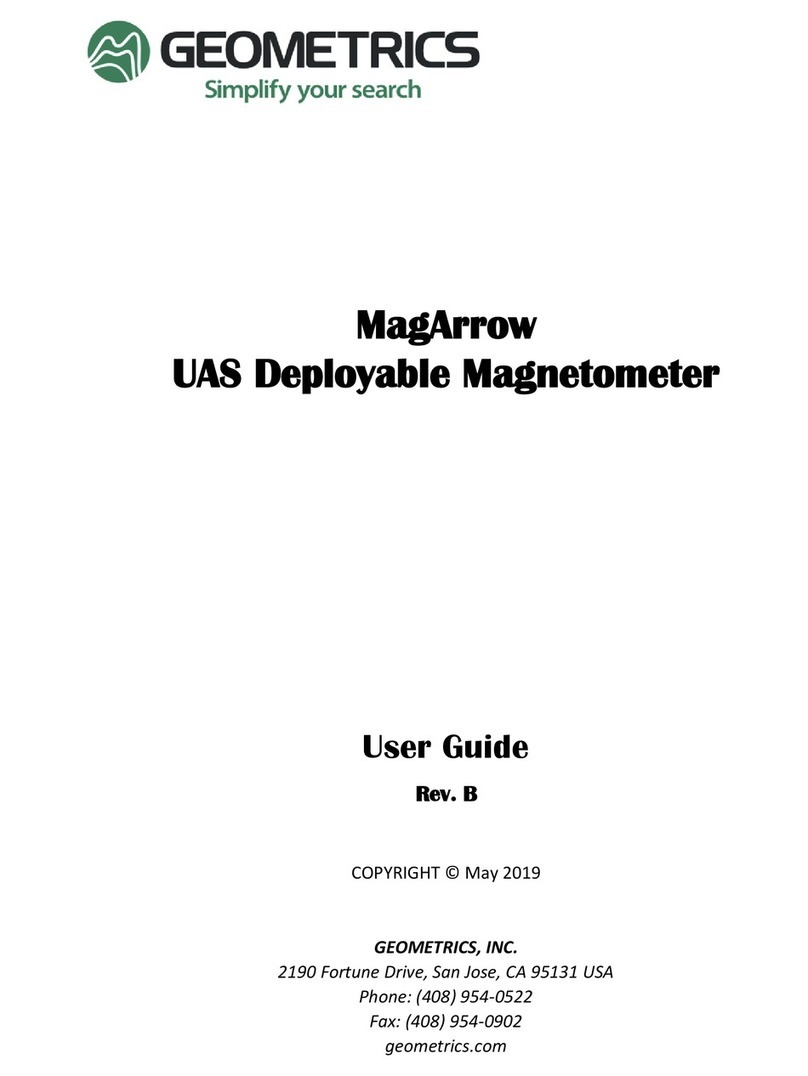
Geometrics
Geometrics MagArrow User manual
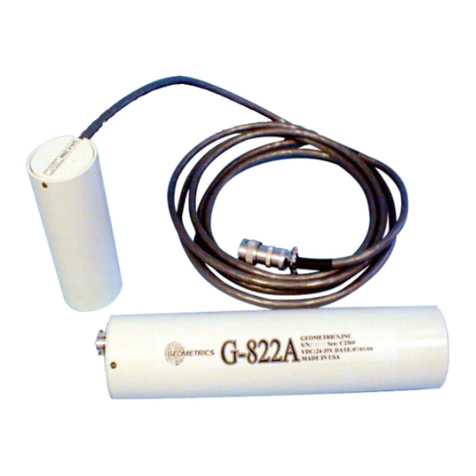
Geometrics
Geometrics G-822A User manual
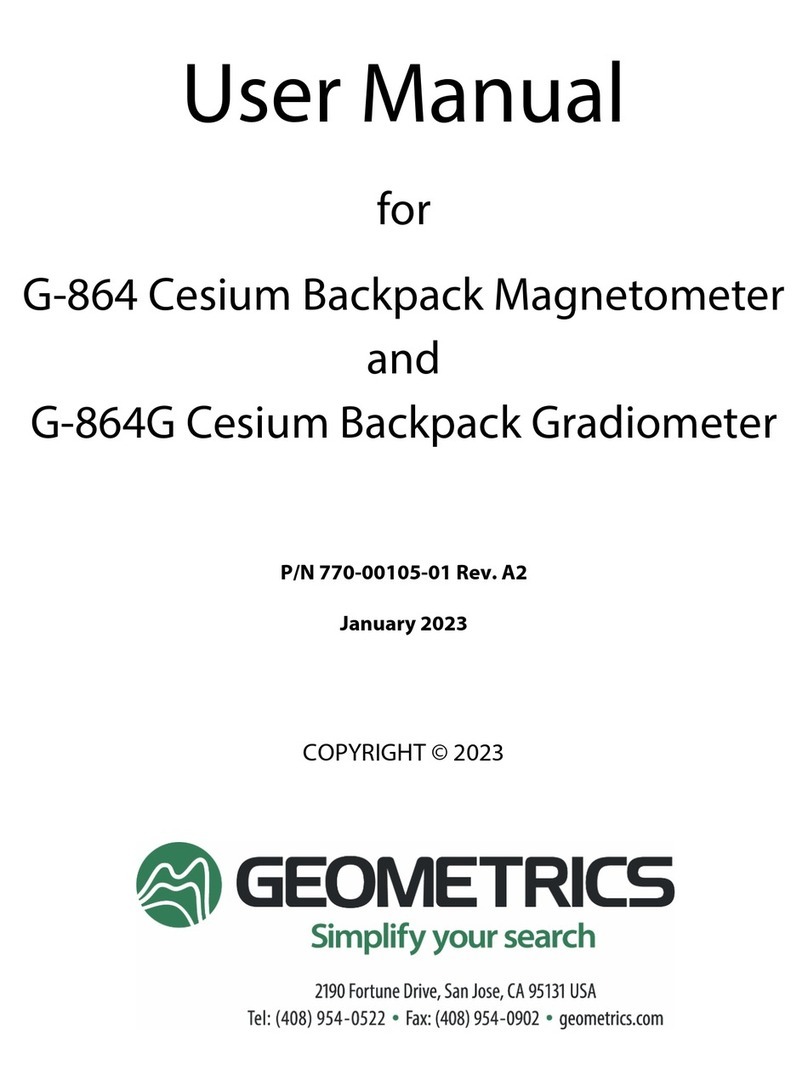
Geometrics
Geometrics G-864 User manual
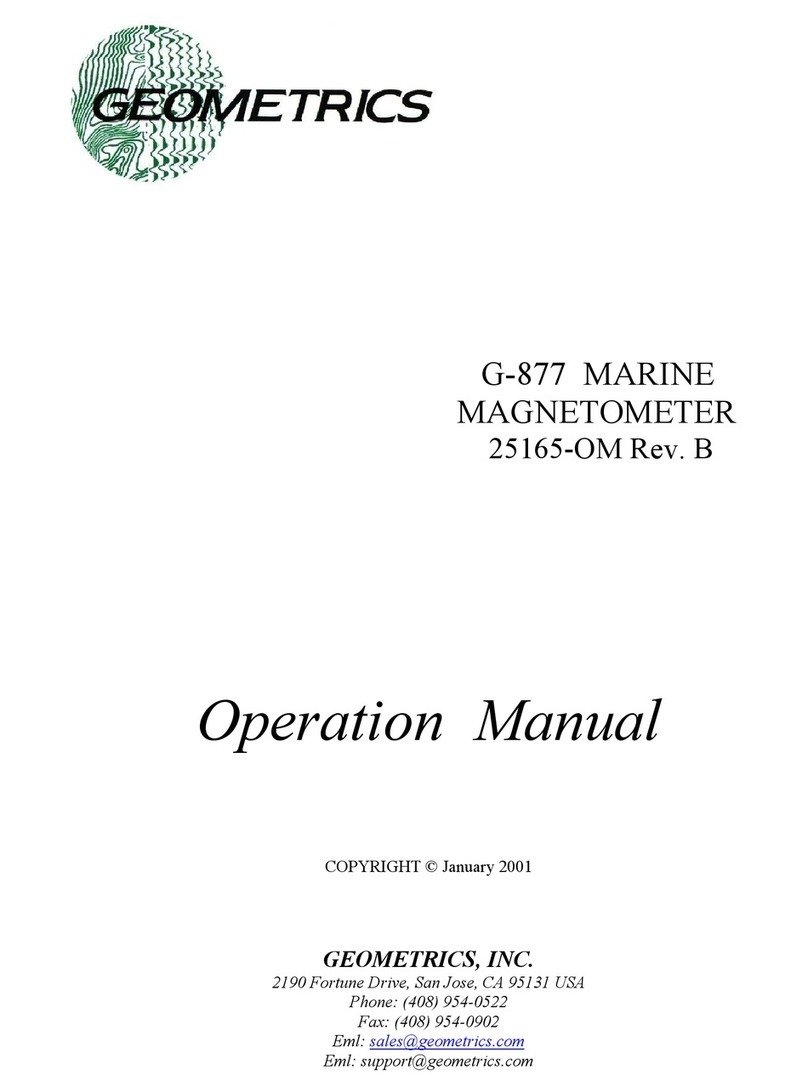
Geometrics
Geometrics G-877 User manual

Geometrics
Geometrics MagArrow User manual

